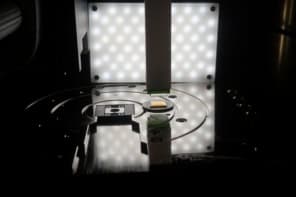Physicists in Japan have discovered a new way to create spin-polarized currents of electrons by simply heating one end of a magnetic sheet. The team was able to make a spin current in the sheet flow 6 mm, which is about 10,000 times further than spin currents can flow in copper wire. The team believes that the phenomenon — called the spin Seebeck effect — could help overcome technological barriers preventing the creation of practical spintronic devices, which use both the spin and charge of electrons to process information.
The intrinsic spin of the electron can either be “up” or “down”, and some physicists believe that this property could be used to store and process information in spintronic devices. Such circuits could be smaller and more energy-efficient than conventional electronic circuits.
But before spintronics can become a commercial reality, researchers have to come up with a reliable way of generating spin currents while also ensuring that these currents can move around a circuit without losing polarization. In copper, for example, a spin-polarized current will only flow about 500 nm before vanishing.
Temperature gradient
Now Eiji Saitoh and colleagues at Keio University in Yokohama have addressed both of these issues with their discovery that a current of spin-polarized electrons can be generated by creating a temperature gradient along a length of a magnetic metal (Nature 455 778).
The team first deposited a 20 nm-thick layer of a Ni81Fe19 alloy onto a sapphire substrate to create a sheet that is 6 mm long and 4 mm wide. They then kept the two opposite ends of the sheet at different temperatures by placing the ends in contact with two independently heated copper blocks.
Ni81Fe19 is a permanent magnet and the sheet was magnetized in the long direction — the same direction as the temperature gradient. The presence of a magnetic field means that electrons of one spin have a different chemical potential energy than electrons with the opposite spin. This imbalance causes an excess of spin-up electrons to build-up at the cool end of the sheet and an excess of spin-down electrons at the warm end.
According to Saitoh this imbalance can be thought of as a “spin voltage” along the sheet, which drives a current of spin-up electrons in one direction and spin-down electrons in the other.
The researchers measured the spin polarization at either end of the sheets with the help of two thin platinum wires — one laid across the cold end and the other across the warm end. As spin current flows into a platinum wire its polarization decays rapidly, creating a voltage across the electrode via the “inverse spin Hall effect” (ISHE).
By measuring the voltages across the electrodes, the team concluded that spin-currents of opposite polarity were flowing out of either end of the sheet. Measurements also showed that the spin voltage was proportional to the temperature difference and that it grew linearly along the length of the sheet — suggesting that spin-currents with well-defined polarization values could be extracted at different lengths along such a sheet.
Spin currents over large distances
Another potentially useful feature of the spin Seebeck effect is that the spin current persists for the entire 6 mm length of the sheet. According to Saitoh, the ability to sustain spin currents over such large distances could “revolutionize” research into the development of spintronic devices.
The team is now looking at whether spin currents generated by the spin Seebeck effect could be used to move magnetic domain walls. If successful, the effect could be used in spintronic “racetrack” memory devices in which data are stored and retrieved by pushing magnetic domains along tiny wires using spin currents.



